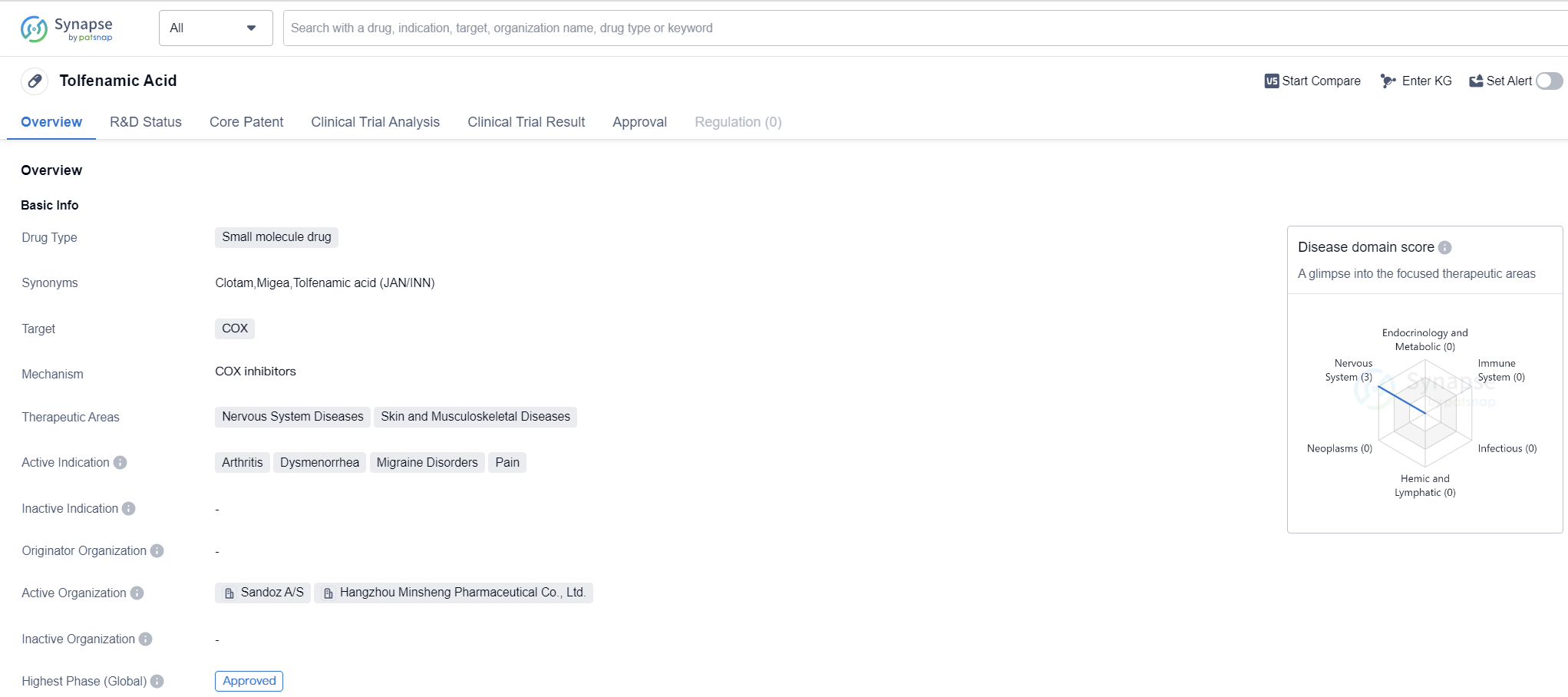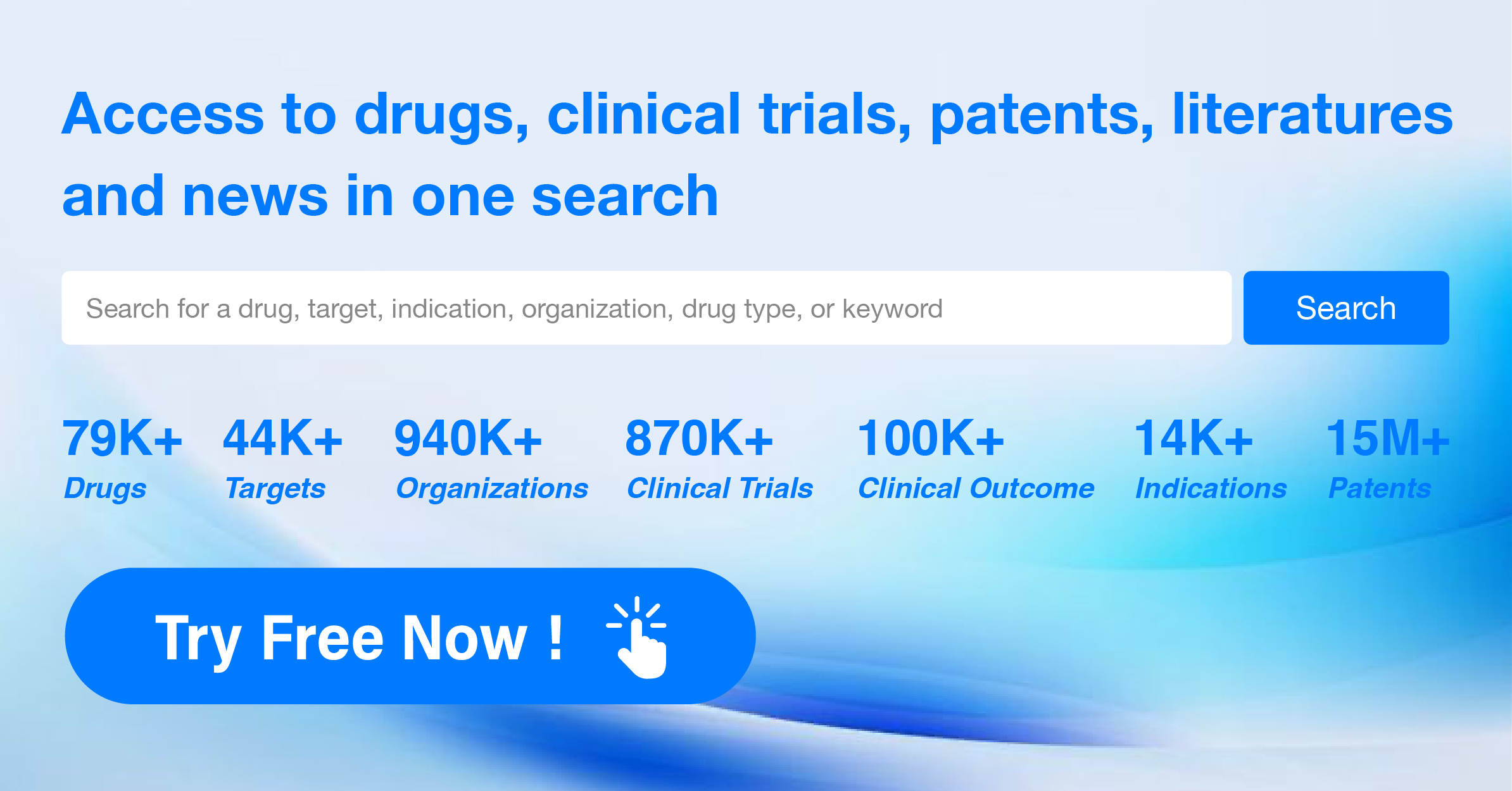Tolfenamic acid: Detailed Review of its Transformative R&D Success
Tolfenamic acid's R&D Progress
Tolfenamic Acid is a small molecule drug that falls under the category of nonsteroidal anti-inflammatory drugs (NSAIDs). It primarily targets the enzyme cyclooxygenase (COX), which plays a crucial role in the production of prostaglandins, substances that are involved in inflammation and pain.
This drug has shown potential therapeutic benefits in the treatment of various conditions related to the nervous system, skin, and musculoskeletal system. Specifically, it has been indicated for the management of arthritis, dysmenorrhea (painful menstrual periods), migraine disorders, and general pain relief.
Tolfenamic Acid has reached the highest phase of development which is approved globally. The drug was first approved in the European Union in June 2000, making it available to patients in that region.
As a small molecule drug, Tolfenamic Acid offers several advantages. It can be easily synthesized and manufactured, allowing for cost-effective production. Additionally, its small size enables it to penetrate cell membranes and reach its target site efficiently.
The approval of Tolfenamic Acid in multiple countries indicates its safety and efficacy profile. Its ability to target COX makes it a promising option for managing pain and inflammation associated with various diseases. The drug's approval for use in nervous system diseases, skin conditions, and musculoskeletal disorders highlights its potential versatility in treating a wide range of conditions.
👇Please click on the image below to directly access the latest data (R&D Status | Core Patent | Clinical Trial | Approval status in Global countries) of this drug.
Mechanism of Action for tolfenamic acid: COX inhibitors
COX inhibitors are a type of medication that work by inhibiting the activity of cyclooxygenase (COX) enzymes. These enzymes are responsible for the production of prostaglandins, which are chemical messengers involved in inflammation, pain, and fever. By blocking the COX enzymes, COX inhibitors reduce the production of prostaglandins, leading to anti-inflammatory, analgesic (pain-relieving), and antipyretic (fever-reducing) effects.
From a biomedical perspective, COX inhibitors are commonly used in the treatment of various conditions such as arthritis, menstrual pain, and acute injuries where inflammation and pain are present. They are particularly effective in reducing the symptoms associated with inflammation, such as swelling, redness, and discomfort. COX inhibitors can be classified into two main types: nonsteroidal anti-inflammatory drugs (NSAIDs) and selective COX-2 inhibitors.
NSAIDs, such as ibuprofen and naproxen, inhibit both COX-1 and COX-2 enzymes, providing broad-spectrum anti-inflammatory effects. On the other hand, selective COX-2 inhibitors, like celecoxib, specifically target the COX-2 enzyme, which is primarily involved in inflammation. These medications are often prescribed when there is a need for long-term pain management with a reduced risk of gastrointestinal side effects associated with non-selective COX inhibitors.
It is important to note that the use of COX inhibitors should be under the supervision of a healthcare professional, as they can have potential side effects, including gastrointestinal ulcers, bleeding, and cardiovascular risks. Additionally, some individuals may be more susceptible to adverse reactions, so personalized medical advice is necessary to determine the appropriate use of COX inhibitors based on an individual's medical history and overall health condition.
Drug Target R&D Trends for tolfenamic acid
COX, or cyclooxygenase, is an enzyme that plays a crucial role in the human body's inflammatory response. It is responsible for the production of prostaglandins, which are hormone-like substances involved in various physiological processes. COX exists in two isoforms, COX-1 and COX-2. COX-1 is constitutively expressed and involved in maintaining normal bodily functions, such as protecting the stomach lining and regulating blood clotting. On the other hand, COX-2 is induced during inflammation and is primarily responsible for the production of prostaglandins that cause pain, fever, and swelling. Understanding the role of COX has led to the development of drugs called COX inhibitors, which are used to manage pain, inflammation, and other related conditions.
According to Patsnap Synapse, as of 12 Sep 2023, there are a total of 598 COX drugs worldwide, from 597 organizations, covering 312 indications, and conducting 8105 clinical trials.
Overall, the target COX presents a competitive landscape with multiple companies, a wide range of indications, and a focus on small molecule drugs. The future development of target COX is likely to continue with advancements in R&D and regulatory approvals, particularly in countries like China that have shown significant progress.
👇Please click on the picture link below for free registration or log in directly if you have a freemium account, you can browse the latest research progress on drugs, indications, organizations, clinical trials, clinical results, and drug patents related to this target
Conclusion
In conclusion, Tolfenamic Acid is a small molecule drug that targets COX and has been approved for use in the treatment of nervous system diseases, skin and musculoskeletal diseases. Its active indications include arthritis, dysmenorrhea, migraine disorders, and general pain relief. With its approval in the global market, Tolfenamic Acid presents a promising option for patients suffering from these conditions.






